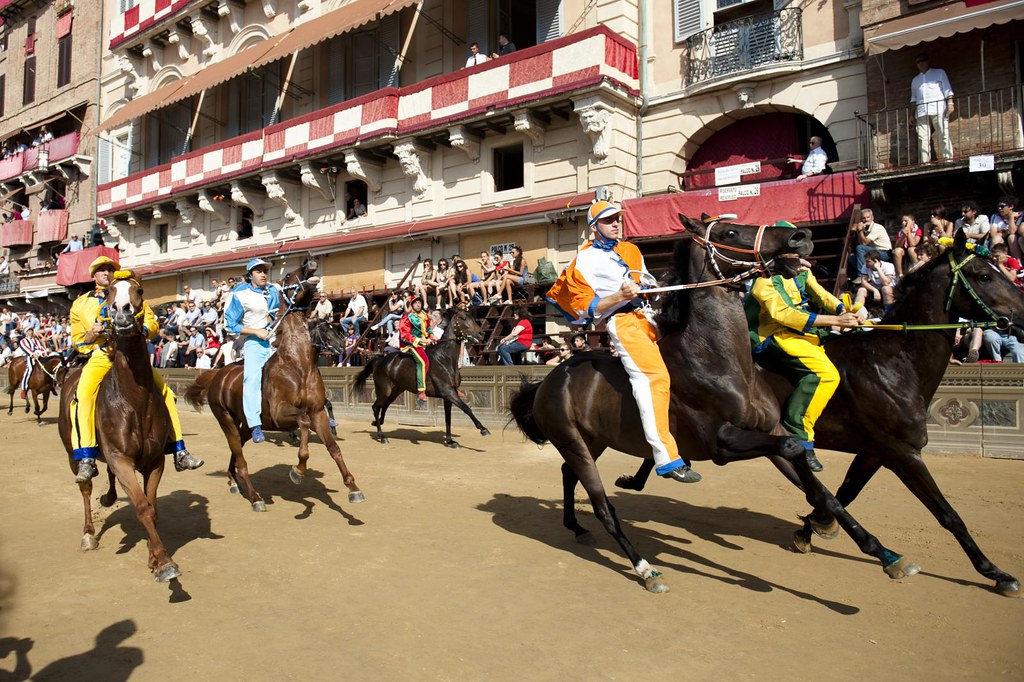The unique cultural context of the Palio is almost as well-known as the horse race itself. In Siena, bets are officially prohibited during the race: in fact, it is less a classical sporting event than a biannual festivity for the city’s seventeen historic neighborhoods (contrade) and their members. Contrade are small, tight-knit communities, united under a banner and a mascot and grounded in a specific territory; they gather throughout the year with the overarching but my no means exhaustive raison d’être of winning as many Palii as possible.
Ten contrade compete in each race. The winner, against all logics of an Anglo-Saxon-style competition, loses money, for it bears many of the costs of the race and will host lavish festivities in the months following it. The official prize is relatively humble: a decorated cloth banner, itself called the Palio, which will be proudly exhibited in the contrada’s museum. Yet this simple material description is almost an insult to the Palio: victories are critical markers in the lives of contrada members, and the overwhelming euphoria of the moment renews each community’s bonds.

The days before the Palio similarly organize the lives of each of Siena’s neighborhood communities. Roaming the streets of the beautiful medieval city from the 13th to the 15th of August, one encounters large groups of contrada members all donning their characteristic handkerchief, jovially sharing a meal, drinking together (from 10 in the morning), and discussing all aspects of the upcoming race, from the recent behavior of potential jockeys to changing weather predictions.
Each night of the preceding week, every contrada hosts a dinner, in a piazza or other public space of the city, with up to 3,000 guests (depending on the size of the contrada) and a set menu (first dish, second dish, dessert, and wine of course!). Spontaneous singing – simple songs that all members of a contrada will know – erupts continuously and increasingly as the aforementioned wine dwindles down. During the day, the streets echo with the rhythmic beats of percussion as the Sienese drummers and flag-bearers practice for the two-hour historical procession that precedes each horse race. The city is now quite tangibly ballooning with the energy, anticipation, and community of its inhabitants.
And all this emotion builds to the cathartic release that is the only thing most anyone outside Italy, and probably Tuscany, is aware of: the approximately 90-second race itself. What it takes to win it is too complex a concoction for this article to begin to describe; it includes year-long strategizing and alliance building as well as, perhaps most importantly, a large dose of sheer luck (culo, Italians would say) on the day itself, as all Sienese have come to learn either to their ecstatic joy or despair.
Here we will focus briefly on one aspect, perhaps the single most important one, of achieving sweet victory: the horse. On this 13th of August, as every year, all competing contrade gathered in the city’s main piazza to hear their destiny. City officials proceeded to extract at random the number of one of the ten horses chosen that morning to participate in the race; and then, in a palpable silence, they similarly extracted one of the ten contrade. Yells of delight were heard from the contrade lucky enough to be paired with a favored horse; long faces were seen for the unluckier ones. As a result of the assignment of the horses, deals were immediately made with jockeys, and within the hour each contrada had a jockey-horse pair.
This year’s upshot: four contrade got the favored rides. The Giraffe, who additionally secured Tittia, the jockey that won the last five Palii; the Goose, whose horse is the only one that has already won a Palio and who as a contrada has not run for the last four years due to a penalty; the Panther; and the Panther’s enemy, the Eagle, the contrada that has not won in the longest time, since 1992.
And yet, the Palio is a fickle thing, and one of the other six contrade may very well end up winning. Even more so as this Palio’s selection of horses is relatively homogenous, with no outstandingly good or poor contestant. We may only stay tuned, discuss every single imaginable possibility and outcome the Sienese do, and then wait to see what plays out.












